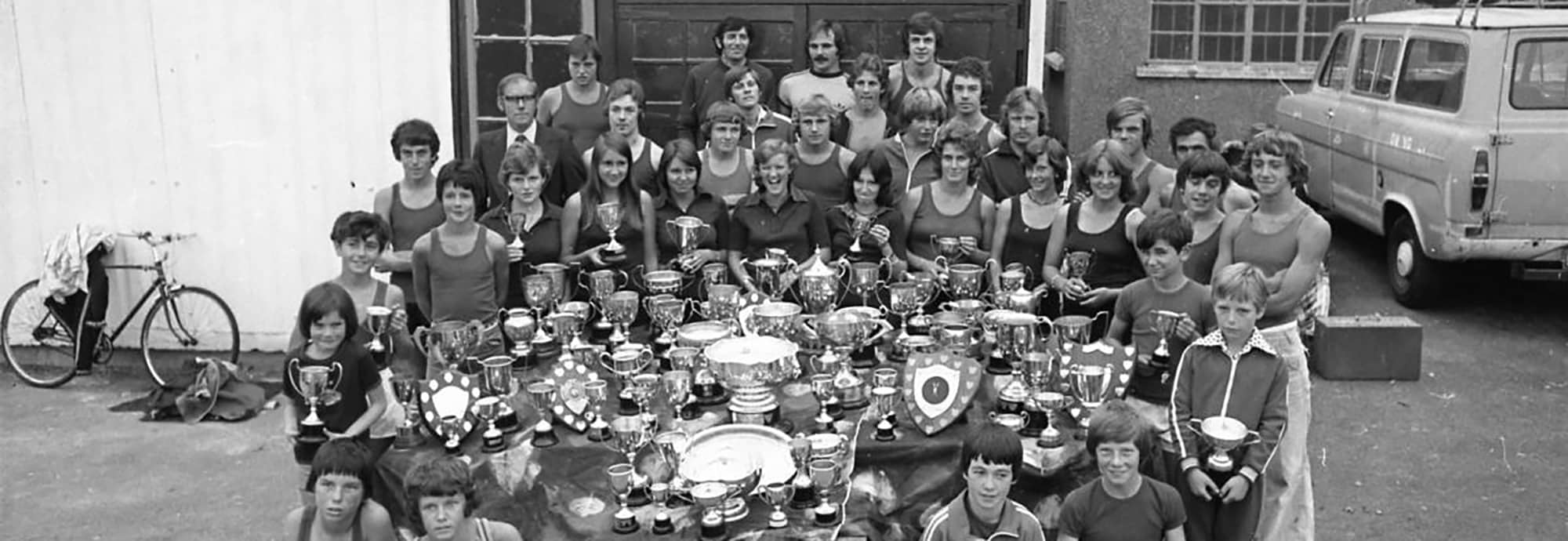

By Lynne Vosper
The tradition of boat building in Cornwall goes back many centuries, and generations of boat builders have used their skills and imagination to create boats that have become works of art as well as functional vessels.
Small working boats have been raced in Cornwall since at least the 19th century and the type of competitive rowing that still goes on in Cornwall today is believed to be the oldest form of traditional fixed-seat rowing to take place anywhere.
In the west of Cornwall, people raced in the 15ft Skiffs similar to the oyster boats of the Fal, but in the east of the county, racing took place between 18ft clinker-built Watermen’s boats mainly on the Tamar. Flashboats have a long pedigree. The term ‘flash boat’ was originally a derogatory one, and dates from a period in their history shortly after the First World War when traditional small Cornish working boats were being modified by some builders for racing. As the racing became more popular, James Goss, a boat builder from Calstock, made the first purpose-built racing boat which was lighter and sleeker and became known by the name ‘flash boat’. An article in Classic Boat magazine in August 2000, tells that “Goss’s yard had a good reputation throughout the Westcountry for building sturdy ship’s boats, skiffs for rowing clubs and four and six oared ‘flash boats’ for the local regattas. The usual cost was £1 per foot, and his four- and six-oared gigs and open flash boats were much in demand locally”.
Flashboats at 18ft length with a 4ft beam, now built in 3 or 4mm ply, and Skiffs at 15ft are smaller and lighter than the 32ft Cornish pilot gigs that have increased in popularity in recent years. Flashboats can be rowed by one, two, three or four rowers, with or without a coxswain. Some races are rowed with oars that are over 8ft long, and some with paddles that are generally under 8ft long. They are the ideal boat for training young rowers in fixed-seat rowing with races in the under 14’s, under 16’s, under 18’s, women’s, men’s, mixed crews, and veteran classes. Terms such as ‘ran-dan’, ‘two oars’, ‘pair of paddles’, ‘oar match’ and ‘four oars’ refer to the various combinations of rowing races at regattas.
Thole pins are used instead of rowlocks; they are a pair of wooden or metal pins set upright on the gunwale on either side of the boat to serve as a fulcrum in rowing. The stretcher or footrest is a wooden bar on which you rest the rowers’ feet and is used to push against during rowing.
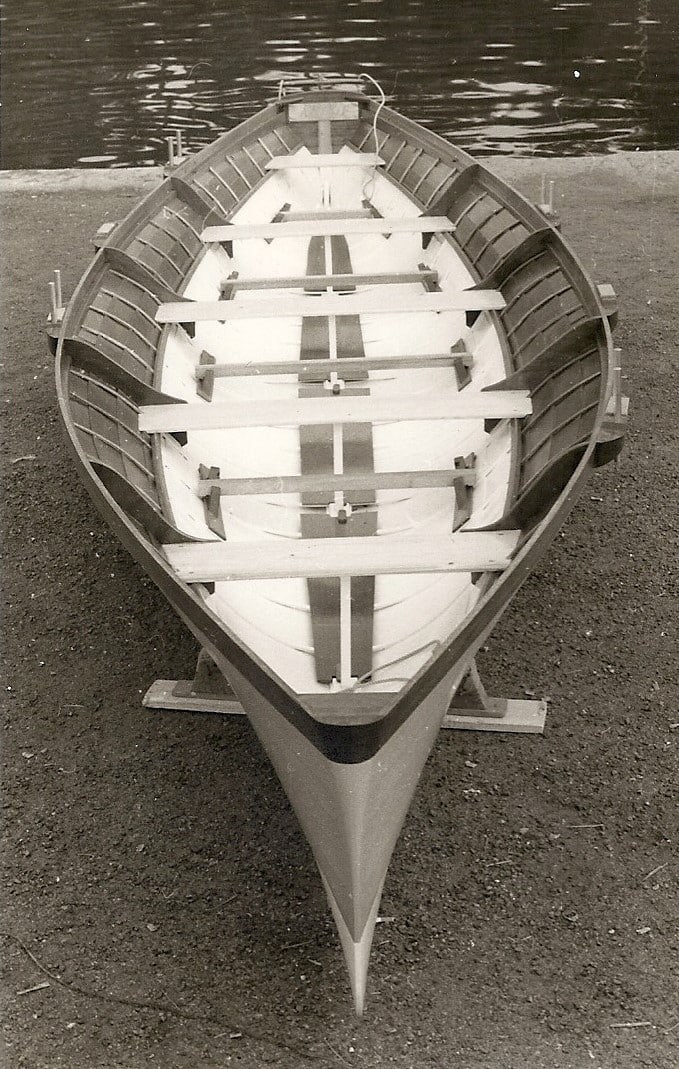
Angof a traditionally built wooden Flashboat. The Vic Angove Boatbuilding Archive ©NMMC
The Penryn Charter Regatta Programme for a regatta held on 20 July 1986 to celebrate the 750th Charter Year of Penryn, gives some information on the history of Penryn Rowing Club. The original Penryn Rowing Club was formed by the late Harry Jennings and Leslie Hilder. In the early days Regattas were held at Malpas, Greenbank, Mylor, Devoran, Penryn, Truro, Hayle, Par, Penzance, Polruan and Fowey. The first boat rowed by the Club was a Skiff built by Harry Jennings called The Flying Anchor. The Club were also successful with a boat called Active.
The story is that it was not long before more competitive rowing was sought by the Club and Robert Hilder entered a team of youngsters and a boat called Celerity in the Torpoint and Saltash regattas to the surprise of those clubs. They arranged races especially for Penryn involving 15ft boats as their boats were all 18ft Flashboats. An ingenious idea was developed by the Penryn Club which was to add an extension of 3ft to the 15ft boats to enable them to compete in the 18ft Flashboat races. The 3ft extension was bolted on when necessary.
This led to the building of Penryn’s first Flashboat, The Saracen, built by Robert Hilder and Michael Gallaway and designed by Percy Dalton in 1968. The first four-oared County championship achieved by Penryn was in a Flashboat called Bits and Pieces built by Robert Hilder and designed by Tommy Bryant. Penryn had many successful boats during this period including Tracey Ann, Rosann, Jubilee, and Weaver. Success was also achieved in the Doug Thomas, Sid and Sue, and Angof. Another Flashboat, built by Robert Hilder and Alan Anderson, was also called Saracen in memory of Harry Jennings and past president, Rex Vinnicombe.
There were originally two rowing Clubs in Penryn, the Penryn Youth Rowing Club and Penryn Town Rowing Club. The clubs amalgamated in the mid-1970s to become Penryn Rowing Club. Pooling the resources of the two Clubs provided a new-look blue-vested Club that few Cornish Clubs could match. One of the Club Rules stated that the object of the Club was to promote and foster interest in the art of rowing and in seamanship among the members and provide facilities for entering rowing competitions.
A new rowing technique, now in common use, was developed among the Penryn rowers where, instead of rowing with two hands on top of the oar, they rowed with one on top and one under. This style has been adopted by Flashboat and pilot gig rowers alike.
During and 1970s and 1980s Penryn Rowing Club were in their heyday and dominated the sport during this period. Among the Flashboat builders for Penryn Rowing Club at this time were Vic Angove, Robert Hilder, Dickie George and Willy Hurley.
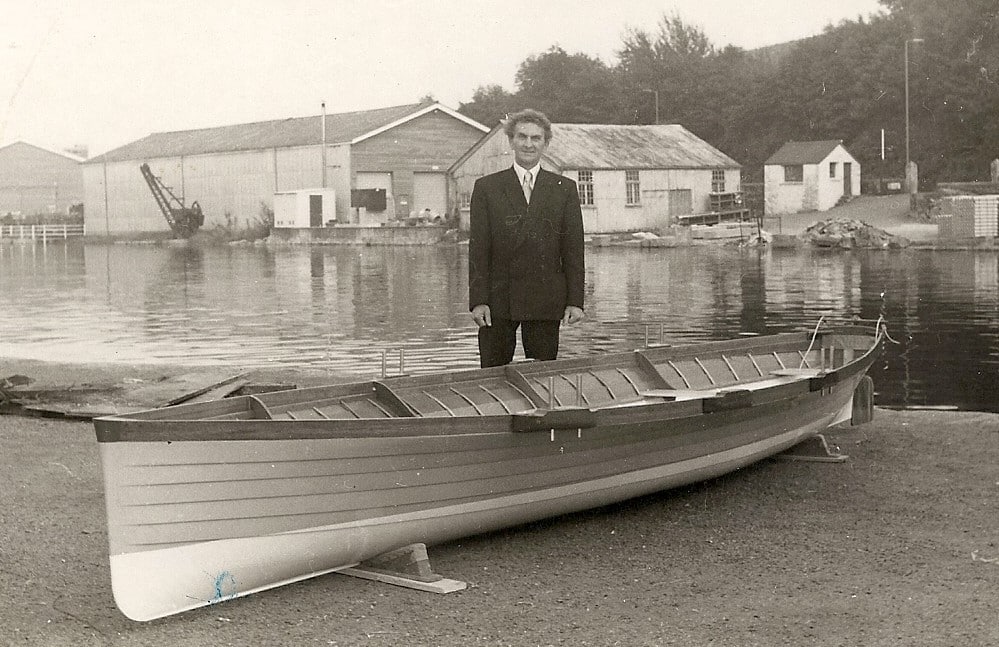
Victor Angove at the launching of his 18-ft Flashboat Angof, in July 1973. The Vic Angove Boatbuilding Archive ©NMMC
Vic Angove, master shipwright and traditional boat builder of Falmouth started his apprenticeship with Falmouth Boat Construction during 1943, following which he was employed as a shipwright by Silley, Cox & Company at Falmouth Docks from 1948 until 1973. He then worked for Dredge & Marine Limited at Ponsharden, Falmouth from 1973 until 1976, before becoming a self-employed boat builder. During his long and varied career, he built or repaired all types of craft but among the boats that gave Vic great pleasure to build were four 18ft Flashboats for Penryn Rowing Club, to his own designs. They were mostly top-secret affairs because of inter-club rivalry. Vic was the Chairman of Penryn Youth Rowing Club, later Penryn Rowing Club for 21 years, and became a Life Member on 5 August 1988 in recognition of his “outstanding service and dedication to the Club”.
The Flashboats built by Vic Angove for Penryn were the Doug Thomas, Sid and Sue, Angof and Carly Louise. Three of these boats were constructed during the early 1970s, and the last one in 1990. The Doug Thomas was named in memory of Alderman DH Thomas who died while Mayor of Penryn and who did much towards setting up the Penryn Activities Centre for Young People. The boat was built in the YMCA building at Bank Place in Falmouth and launched from the dinghy hard at Grove Place by Mrs Jean Thomas, the former Mayoress. The Sid and Sue was clinker built and was constructed in the Mylor and Penryn Boxing Club premises in Penryn and was named after the local couple who sponsored her. The Angof was another clinker-built design and was constructed in the Rowing Club building on Penryn Quay. The fourth Flashboat built by Vic in 1990 was the Carly Louise, a carvel design, and was named after, and by his young granddaughter.
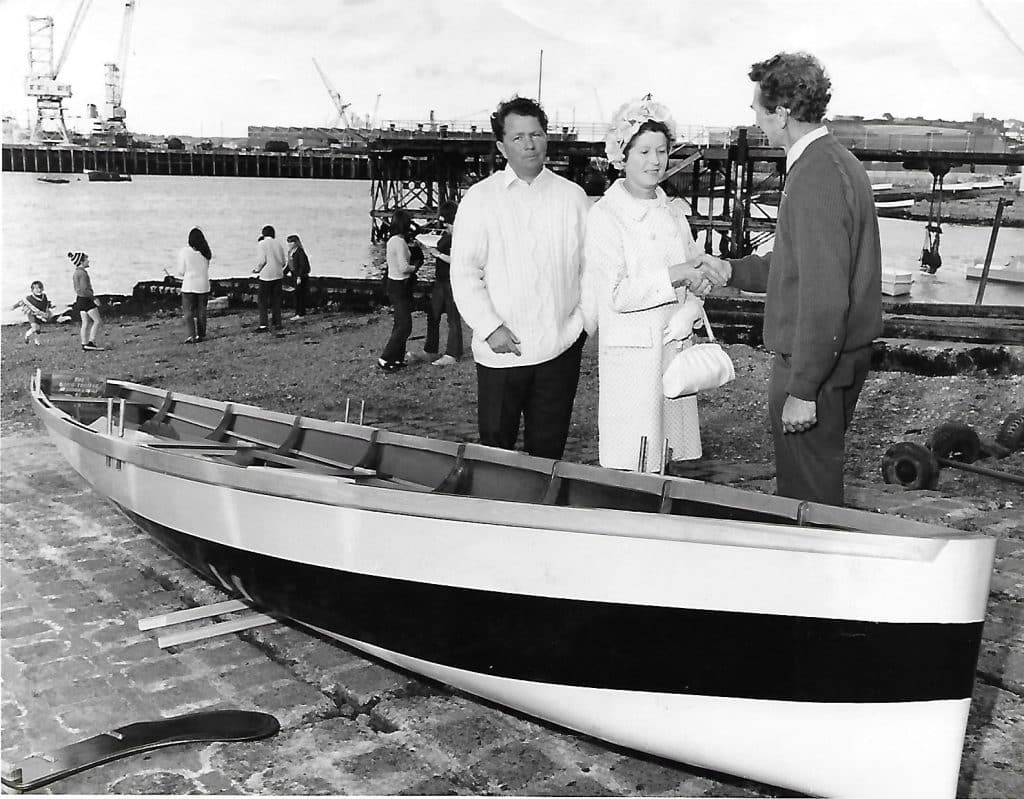
At the launching and naming ceremony of the Doug Thomas, Youth Club Chairman, Clive Sampson is seen with Mrs Jean Thomas, Former Mayoress of Penryn and Victor Angove, who designed and built the boat. Private Collection.
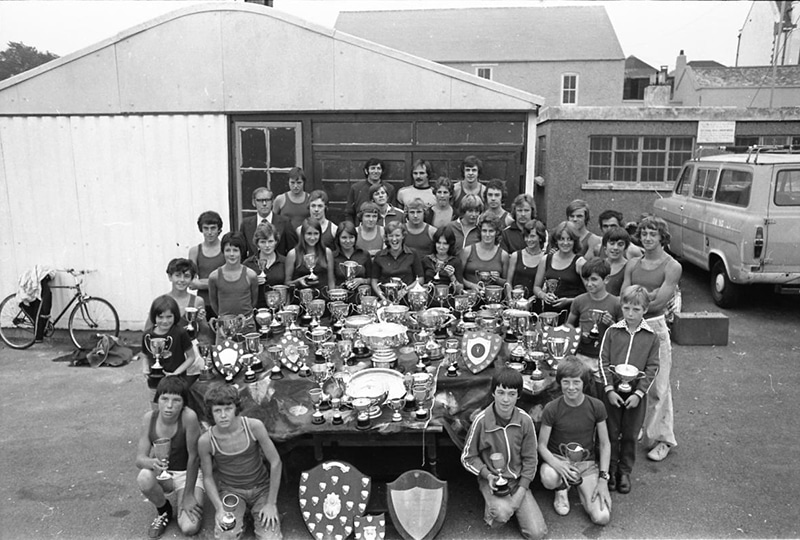
The Club was extremely successful and in November 1978 a Civic Reception was held to honour them at the Royal Duchy Hotel in Falmouth by Penryn Town Council.
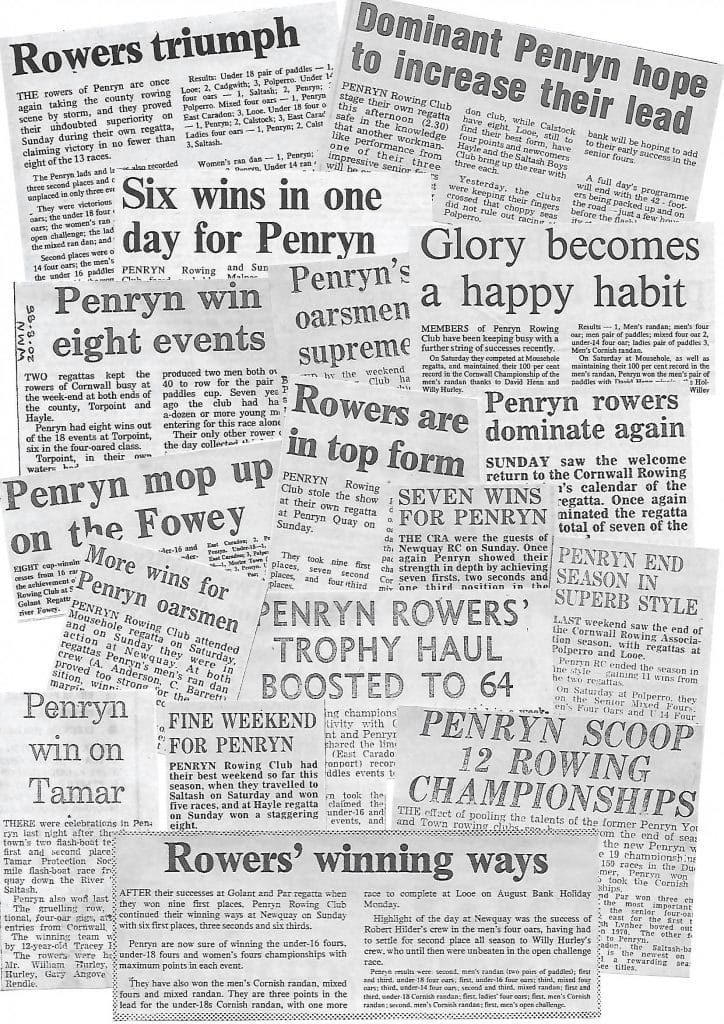
Headlines from local newspapers including the Falmouth Packet, West Briton, Western Morning News, Cornishman, Cornish Guardian and Cornish Times. Private Collection.
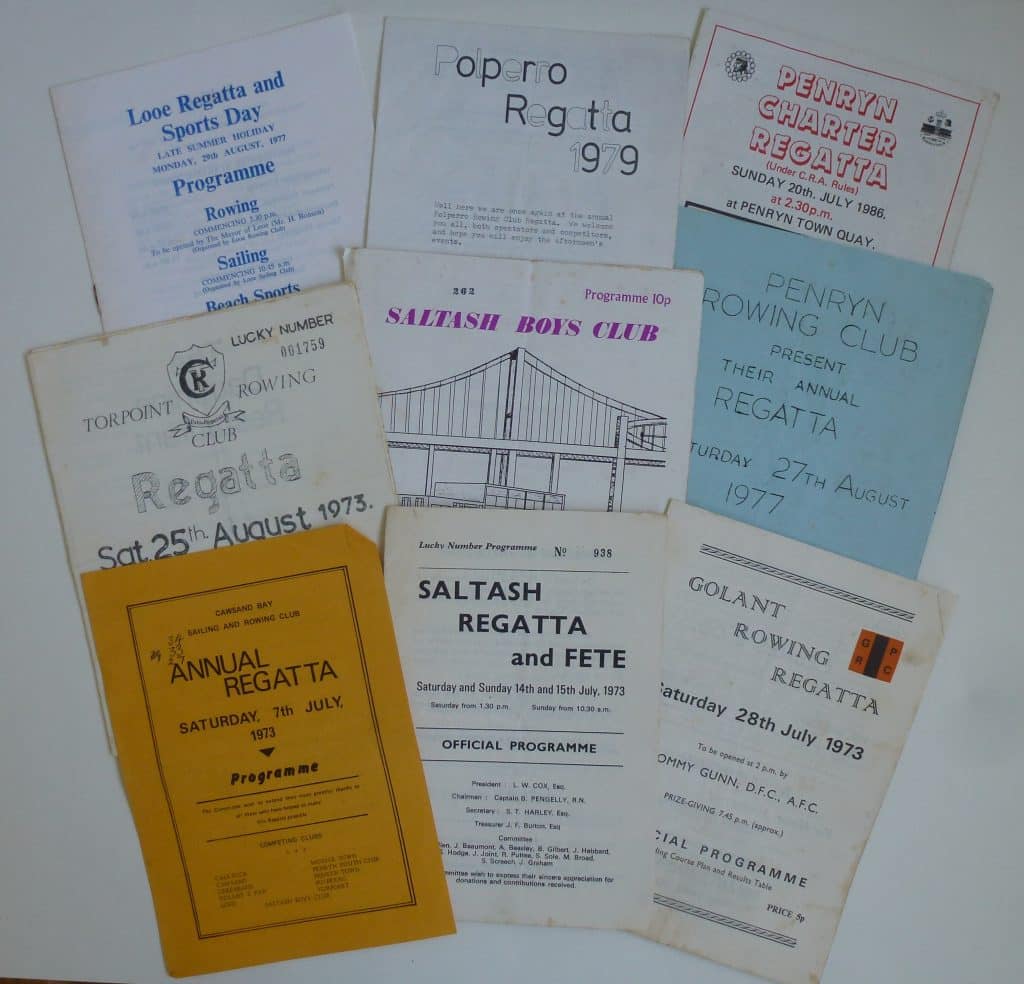
Programmes from Rowing Regattas. Private Collection.
The rowing calendar was always very busy, and regattas were held at Penryn, Mousehole, Hayle Pool, Saltash, Torpoint, Calstock, Looe, Polperro, Newquay, Cawsand, Par, Falmouth, on Sibley Back Lake, and in the Plymouth area at Sutton Harbour, Morice Town, and Mutton Cove. The Two Castles Race was from Penryn to St Mawes Castle over to Pendennis Castle and finishing at Penryn. There were Head of River Races on the Fal, River Fowey and on the Tamar from Weir Quay to Saltash over 18 miles. One of the attractions of Flashboat rowing for rowers and spectators is the sight of the boats fighting for position as they round the marks on the course.
Cove rowing became popular in the mid-1970s and was mainly centred around the Lizard peninsula where racing took place at Cadgwith, Mullion, Coverack, Porthoustock, Porthallow, Durgan and other coastal villages in the area. Penryn raced in their 15ft Skiffs with other competitive rowers. The Skiffs are weighed at the start of the season to check they weigh at least the regulation 190 lbs.
Gig rowing began to increase from 1985 and the Flash Boats and Skiffs were slightly eclipsed by the 32ft Cornish Pilot Gigs. Previously the only racing gigs were at Newquay Rowing Club and on the Isles of Scilly. The first County Gig Championship took place in 1970 and the Newquay gigs Newquay, Dove and Treffry were used by the competing clubs. Penryn Rowing Club won the Men’s County Gig Championships at Newquay in 1976, 1979 and 1982.
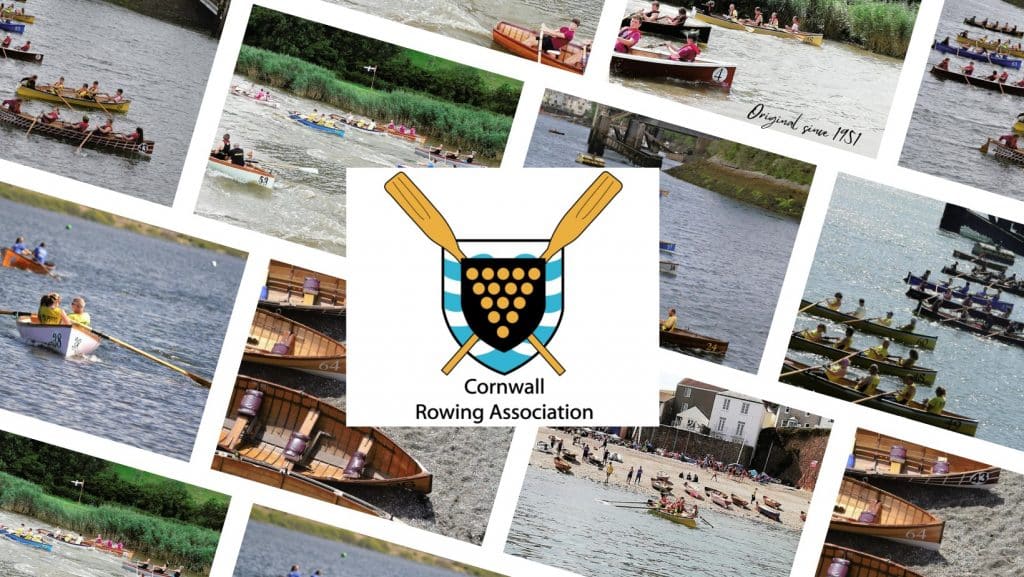
The Cornwall Rowing Association logo ©CRA. By kind permission of the Cornwall Rowing Association.
The programme for the Penryn Charter Regatta 20 July 1986 records that the Cornwall Rowing Association (CRA) was founded in 1951 by Dickie George, George Northey, George Angove, Frankie Cocks, Leslie Hilder and Harry Jennings, a group of enthusiasts from the Fal and Helford area where the 15ft class of boat, the Skiff, was raced. Their meetings were held at the Truro Gas Showrooms. Penryn was a founder member Club of the CRA.
In the mid-1960s the east of the county rowers were invited into the CRA. The 15ft boats from the west were united with the 18ft boats from the east and rowing under the rules of the new Association commenced in 1951, with regattas including races for both classes. Points were awarded at the regattas counting towards County Championships. Part of the aims of the CRA was to promote rowing in the County and to protect and retain a traditional part of the Cornish heritage. From those early days the CRA went from strength to strength producing some of the finest rowers in the South-West of England.
The Cornwall Rowing Association co-ordinates traditional Cornish Flash Boat and Skiff rowing. Rowing is an excellent sport and the local CRA clubs are determined to carry on this traditional form of racing. Chris Baker, Publicity Officer for the CRA, is passionate about preserving the history of fixed-seat rowing and believes “the Cornish Flashboat racing is the oldest, longest running form of rowing in England (at least), as the Flashboat is directly descended from the Watermen’s Boats”. The programme for the CRA Regattas can be found on their Facebook page.
Penryn Rowing Club are still based on Exchequer Quay, Penryn and they row Skiffs, Flash boats and Cornish Pilot Gigs. For more information visit their website www.penrynrowingclub.co.uk
The Bartlett Blog is written and produced by the volunteers who staff The Bartlett Maritime Research Centre and Library of National Maritime Museum Cornwall. Penryn Rowing Club and Their Golden Years in the 1970s and 80s was written by Lynne Vosper, a Bartlett Library volunteer, and daughter of Vic Angove, re-visiting two Curator’s Choice articles she wrote in 2012, and a private family archive.
The Bartlett Library holds a Collection of over 20,000 volumes and offers access to one of the finest collections of maritime reference books, periodicals and archival material. The Bartlett Blog reflects the diversity of material available in The Bartlett Library.

National Maritime
Museum Cornwall Trust
Discovery Quay
Falmouth Cornwall
TR11 3QY
View Map
See our opening hours
Tel: +44(0)1326 313388
Email: enquiries@nmmc.co.uk